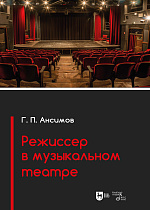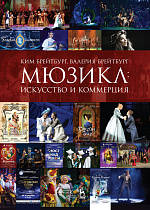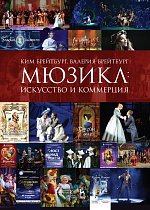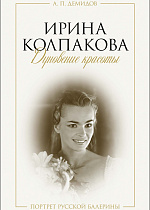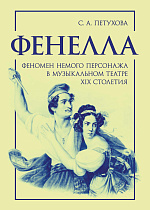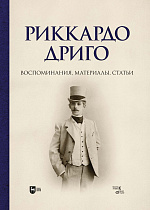История искусства музыкального театра - все книги по дисциплине. Издательство Лань
Сохранить список:
Excel
Excel
Закрыть
Выгрузка списка книг доступна только авторизованным пользователям. Авторизоваться
Георгий Павлович Ансимов (1922-2015) – одна из вершин мировой оперно-музыкальной режиссуры. За свою творческую жизнь поставил более ста спектаклей – в России, СССР, Чехии, Австрии, Германии, Китае, Корее, в Прибалтике. С 1954 преподавал в ГИТИСе, воспитав целую плеяду выдающихся мастеров музыкального театра, его ученики и по сей день блистают на сценах самых знаковых театрах мира.
Настоящая книга, жанр которой не так легко определить, приоткрывает завесу творческой деятельности режиссера, повествующего в увлекательной манере о своей работе в музыкальном театре. Автор делится размышлениями, воспоминаниями, меткими аналитическими наблюдениями о постановках «Фра-Дьявола», «Укрощения строптивой», «Орфея в аду», «Фиалки Монмарта», «Войны и мира» и др.
Книга адресована специалистам и всем, кто интересуется миром музыкального театра.
Georgy Pavlovich Ansimov (1922–2015) is one of the world’s most prominent opera and music directors. Throughout his career, he staged more than a hundred performances in Russia, the USSR, the Czech Republic, Austria, Germany, China, Korea, and the Baltics. Since 1954, he taught at GITIS, having trained a galaxy of outstanding masters of music theatre; his students still shine on the stages of the world’s most iconic theatres.
This book, the genre of which is not so easy to define, lifts the curtain on the director’s method. In a fascinating manner he tells about his work in the music theatre. The author shares his thoughts, memories, keen analytical observations on the productions of Fra Diavolo, The Taming of the Shrew, Orpheus in the Underworld, The Violet of Montmartre, War and Peace and others.
The book is addressed to experts and anyone interested in the world of music theatre.
Настоящая книга, жанр которой не так легко определить, приоткрывает завесу творческой деятельности режиссера, повествующего в увлекательной манере о своей работе в музыкальном театре. Автор делится размышлениями, воспоминаниями, меткими аналитическими наблюдениями о постановках «Фра-Дьявола», «Укрощения строптивой», «Орфея в аду», «Фиалки Монмарта», «Войны и мира» и др.
Книга адресована специалистам и всем, кто интересуется миром музыкального театра.
Georgy Pavlovich Ansimov (1922–2015) is one of the world’s most prominent opera and music directors. Throughout his career, he staged more than a hundred performances in Russia, the USSR, the Czech Republic, Austria, Germany, China, Korea, and the Baltics. Since 1954, he taught at GITIS, having trained a galaxy of outstanding masters of music theatre; his students still shine on the stages of the world’s most iconic theatres.
This book, the genre of which is not so easy to define, lifts the curtain on the director’s method. In a fascinating manner he tells about his work in the music theatre. The author shares his thoughts, memories, keen analytical observations on the productions of Fra Diavolo, The Taming of the Shrew, Orpheus in the Underworld, The Violet of Montmartre, War and Peace and others.
The book is addressed to experts and anyone interested in the world of music theatre.
В 2024 году исполнилось 180 лет со дня рождения величайшего композитора, признанного классика русской академической музыки Николая Андреевича Римского-Корсакова. Книга музыкального критика, искусствоведа Александра Матусевича призвана проследить интерпретационные подходы к сочинениям композитора в наши дни – в первой четверти XXI века. На большом количестве примеров, которые автор наблюдал вживую и анализировал в виде рецензий для различных изданий, он стремится показать разнообразие этих подходов. Перед читателем пройдет длинная череда постановок оперных театров России и зарубежья, концертных программ, дающих широкую палитру впечатлений для понимания того, какое место сегодня занимает музыкальное наследие Римского-Корсакова в культурном контексте нашей эпохи.
Книга адресована, как музыкантам-профессионалам, так и всем любителям оперного искусства.
The year 2024 was marked by 180 years birth anniversary of Nikolai Andreevich Rimsky-Korsakov, the great composer, the recognized classic of Russian academic music. The book by Alexander Matusevich, music critic and art historian, aims to trace the interpretation approaches to the composer’s works nowadays, in the first quarter of the 21st century. The author tries to show the diversity of these approaches, basing on a large number of examples he had observed live and analyzed in the reviews for various media. The reader will be able to meet a long series of opera houses productions in Russia and abroad, concert recitals, providing a wide range of impressions to understand the place that Rimsky-Korsakov’s musical heritage occupies today in the cultural sphere of our time.
The book is addressed to both professional musicians and all lovers of opera art.
Книга адресована, как музыкантам-профессионалам, так и всем любителям оперного искусства.
The year 2024 was marked by 180 years birth anniversary of Nikolai Andreevich Rimsky-Korsakov, the great composer, the recognized classic of Russian academic music. The book by Alexander Matusevich, music critic and art historian, aims to trace the interpretation approaches to the composer’s works nowadays, in the first quarter of the 21st century. The author tries to show the diversity of these approaches, basing on a large number of examples he had observed live and analyzed in the reviews for various media. The reader will be able to meet a long series of opera houses productions in Russia and abroad, concert recitals, providing a wide range of impressions to understand the place that Rimsky-Korsakov’s musical heritage occupies today in the cultural sphere of our time.
The book is addressed to both professional musicians and all lovers of opera art.
Предлагаемое издание посвящено одной из важнейших постановок московского балетмейстера Александра Алексеевича Горского (1871–1924) — мимодраме «Дочь Гудулы». Она была показана в 1902 году и, несмотря на то что быстро сошла со сцены, в истории отечественного балета осталась не только как первое реформаторское произведение своего автора, но и как своего рода точка отсчёта преобразований в русском хореографическом театре.
Две части уникального издания одновременно и дополняют друг друга, и представляют самостоятельный интерес. Клавир мимодрамы впервые предлагается читателям, в исследовании даётся краткая история создания и сценической жизни постановки и подробно анализируется музыка «Дочери Гудулы» — та составляющая спектакля, которая способна сохраняться вне зависимости от прошедшего со времени премьеры времени.
Издание будет интересно теоретикам и практикам балета, музыковедам, культурологам и всем любителям музыкального театра.
The current edition is devoted to the mime drama Gudula’s Daughter, one of the most important productions by Alexander Alexeevich Gorsky (1871–1924), the Moscow ballet master. It was first shown in 1902 and, despite the fact that it quickly disappeared from stage, it remained in the Russian ballet history not only as the first innovative work of its author, but also as a kind of a starting point for transformations in the Russian choreographic theater.
Two parts of this unique edition complement each other and are at the same time of independent interest. The piano score of the mime drama is published for the first time, the study provides a brief history of the creation and stage life of the production and analyzes in detail the music of the Gudula’s Daughter, that part of the performance that can continue to exist regardless of the time that has passed since the premiere.
The edition will be of interest to ballet theorists and practitioners, musicologists, culture experts and all the music theater lovers.
Две части уникального издания одновременно и дополняют друг друга, и представляют самостоятельный интерес. Клавир мимодрамы впервые предлагается читателям, в исследовании даётся краткая история создания и сценической жизни постановки и подробно анализируется музыка «Дочери Гудулы» — та составляющая спектакля, которая способна сохраняться вне зависимости от прошедшего со времени премьеры времени.
Издание будет интересно теоретикам и практикам балета, музыковедам, культурологам и всем любителям музыкального театра.
The current edition is devoted to the mime drama Gudula’s Daughter, one of the most important productions by Alexander Alexeevich Gorsky (1871–1924), the Moscow ballet master. It was first shown in 1902 and, despite the fact that it quickly disappeared from stage, it remained in the Russian ballet history not only as the first innovative work of its author, but also as a kind of a starting point for transformations in the Russian choreographic theater.
Two parts of this unique edition complement each other and are at the same time of independent interest. The piano score of the mime drama is published for the first time, the study provides a brief history of the creation and stage life of the production and analyzes in detail the music of the Gudula’s Daughter, that part of the performance that can continue to exist regardless of the time that has passed since the premiere.
The edition will be of interest to ballet theorists and practitioners, musicologists, culture experts and all the music theater lovers.
Творчество тандема Кима и Валерии Брейтбургов успешно вписано в контекст существования мюзикла в современной отечественной социокультурной среде.
Приёмы создания мюзиклов и постановочные принципы, применяемые авторами в своей театральной деятельности, послужили основой для написания этой книги.
Работа содержит ряд важных наблюдений и выводов, которые могут послужить основой для практической деятельности композиторов и либреттистов, режиссёров и актёров музыкального театра, эстрадных артистов-вокалистов и продюсеров, занимающихся созданием и постановкой мюзиклов.
Материалы, содержащиеся в книге, также могут быть полезны при рассмотрении коммуникативных условий, напрямую влияющих на коммерческую успешность постановок.
Приёмы создания мюзиклов и постановочные принципы, применяемые авторами в своей театральной деятельности, послужили основой для написания этой книги.
Работа содержит ряд важных наблюдений и выводов, которые могут послужить основой для практической деятельности композиторов и либреттистов, режиссёров и актёров музыкального театра, эстрадных артистов-вокалистов и продюсеров, занимающихся созданием и постановкой мюзиклов.
Материалы, содержащиеся в книге, также могут быть полезны при рассмотрении коммуникативных условий, напрямую влияющих на коммерческую успешность постановок.
Творчество тандема Кима и Валерии Брейтбургов успешно вписано в контекст существования мюзикла в современной отечественной социокультурной среде.
Приёмы создания мюзиклов и постановочные принципы, применяемые авторами в своей театральной деятельности, послужили основой для написания этой книги.
Работа содержит ряд важных наблюдений и выводов, которые могут послужить основой для практической деятельности композиторов и либреттистов, режиссёров и актёров музыкального театра, эстрадных артистов-вокалистов и продюсеров, занимающихся созданием и постановкой мюзиклов.
Материалы, содержащиеся в книге, также могут быть полезны при рассмотрении коммуникативных условий, напрямую влияющих на коммерческую успешность постановок.
Приёмы создания мюзиклов и постановочные принципы, применяемые авторами в своей театральной деятельности, послужили основой для написания этой книги.
Работа содержит ряд важных наблюдений и выводов, которые могут послужить основой для практической деятельности композиторов и либреттистов, режиссёров и актёров музыкального театра, эстрадных артистов-вокалистов и продюсеров, занимающихся созданием и постановкой мюзиклов.
Материалы, содержащиеся в книге, также могут быть полезны при рассмотрении коммуникативных условий, напрямую влияющих на коммерческую успешность постановок.
Впервые публикуемая рукопись балетного критика Александра Павловича Демидова (1944–1990) сравнительно недавно обнаружилась в его архиве и посвящена творчеству выдающейся русской балерины Ирины Александровны Колпаковой. Ее творческий путь занял 1950–80-е гг. и протекал на сцене Кировского, ныне Мариинского театра. Сценический репертуар включил в себя сочинения М. Петипа, Ж. Коралли и Ж. Перро, М. Фокина, Ю. Григоровича, И. Бельского, Л. Якобсона, др. Автор застал расцвет ее сценической карьеры и запечатлел формирование стиля и исключительной артистической индивидуальности. Он анализирует послужной лист балерины не линейно, а с точки зрения высших совпадений ее духовной природы с хореографическим замыслом. И на основании этого выводит собственную концепцию, определяя место и роль Ирины Колпаковой в истории русского балета ХХ в.
Книга привлечет внимание балетоведов и театроведов и также будет интересна всем, в ком жива мысль о судьбах русского балета. Издание иллюстрировано новыми фотографиями.
The сurrent edition is the first publication of the manuscript by the ballet critic Alexander Pavlovich Demidov (1944–1990), which was recently discovered in his archive. It is devoted to the work of the outstanding Russian ballerina Irina Alexandrovna Kolpakova. Her career took place between the 1950s and the 1980s on the stage of the Kirov (now the Mariinsky) Theatre. Her stage repertoire included pieces by M. Petipa, J. Coralli and J. Perrot, M. Fokine, Y. Grigorovich and others. The author witnessed the heyday of her stage career and captured the formation of her style and exceptional artistic individuality. He analyzes the ballerina’s roles list not linearly but from the point of view of the highest concordance between her spiritual nature and the choreographic concept. Following these foundations, he makes his own concept, defining Irina Kolpakova’s place and role in the Russian ballet history of the 20th century.
The book will attract the attention of ballet and theatre experts and will also be of interest to anyone who is curious about the fate of Russian ballet. The edition is newly illustrated.
Книга привлечет внимание балетоведов и театроведов и также будет интересна всем, в ком жива мысль о судьбах русского балета. Издание иллюстрировано новыми фотографиями.
The сurrent edition is the first publication of the manuscript by the ballet critic Alexander Pavlovich Demidov (1944–1990), which was recently discovered in his archive. It is devoted to the work of the outstanding Russian ballerina Irina Alexandrovna Kolpakova. Her career took place between the 1950s and the 1980s on the stage of the Kirov (now the Mariinsky) Theatre. Her stage repertoire included pieces by M. Petipa, J. Coralli and J. Perrot, M. Fokine, Y. Grigorovich and others. The author witnessed the heyday of her stage career and captured the formation of her style and exceptional artistic individuality. He analyzes the ballerina’s roles list not linearly but from the point of view of the highest concordance between her spiritual nature and the choreographic concept. Following these foundations, he makes his own concept, defining Irina Kolpakova’s place and role in the Russian ballet history of the 20th century.
The book will attract the attention of ballet and theatre experts and will also be of interest to anyone who is curious about the fate of Russian ballet. The edition is newly illustrated.
Настоящая книга является первой попыткой рассмотрения феномена немого персонажа в оперном театре романтического XIX века. Главное место в исследовании занимает образ Фенеллы — титульной роли в опере Даниэля Обера и Эжена Скриба «Немая из Портичи» (1828), созданной для пантомимной солистки. Некогда это сочинение имело фантастическую популярность, а безмолвная партия становилась предметом конкуренции артисток разного амплуа: балерин и мимисток, драматических актрис и певиц. История постановок оперы на Западе и в России базируется на подробностях биографий этих исполнительниц, их взаимоотношений, пристрастий и интерпретаций.
Книга снабжена иллюстрациями и развёрнутыми приложениями, помогающими ориентироваться в театральном мире ушедших времён. Издание предназначено для специалистов театра и музыки, а также для всех, кто любит балетное искусство.
The current book is the first attempt to study the phenomenon of a mute character in the romantic 19th century opera theatre. The main place in the study belongs to the Fenella image, the title role in “La Muette de Portici” (“The Mute Girl of Portici”, 1828), the opera by Daniel Auber and Eugène Scribe, created for a solo pantomime performer. The piece used to be incredibly popular, and the mute part became the subject of competition between artists of a different type: ballet dancers and mime artists, drama actresses and singers. The history of the opera’s productions in the West and in Russia is based on these performers’ biographical moments, their relationships, sympathies and interpretations.
The book is illustrated and provided with detailed appendices, aimed to help readers understand the theatrical world of bygone times. The edition is intended for theatre and music experts, as well as for all music theatre lovers.
Книга снабжена иллюстрациями и развёрнутыми приложениями, помогающими ориентироваться в театральном мире ушедших времён. Издание предназначено для специалистов театра и музыки, а также для всех, кто любит балетное искусство.
The current book is the first attempt to study the phenomenon of a mute character in the romantic 19th century opera theatre. The main place in the study belongs to the Fenella image, the title role in “La Muette de Portici” (“The Mute Girl of Portici”, 1828), the opera by Daniel Auber and Eugène Scribe, created for a solo pantomime performer. The piece used to be incredibly popular, and the mute part became the subject of competition between artists of a different type: ballet dancers and mime artists, drama actresses and singers. The history of the opera’s productions in the West and in Russia is based on these performers’ biographical moments, their relationships, sympathies and interpretations.
The book is illustrated and provided with detailed appendices, aimed to help readers understand the theatrical world of bygone times. The edition is intended for theatre and music experts, as well as for all music theatre lovers.
В предлагаемой книге собраны документы, статьи и материалы, посвященные жизни и творчеству Риккардо Дриго (1846-1930). Итальянский композитор и дирижер, более сорока лет служивший капельмейстером оркестра сначала итальянской оперной, затем балетной труппы Императорских театров Петербурга, он оставил значительный след в истории русского музыкального театра. Сведений о его жизни и работе в России сохранилось немного, и даже они оказались разрозненны по архивам и музеям разных городов страны. В данной книге предпринята попытка собрать воедино документы, исследования, воспоминания и различные материалы, имеющие отношение к Р. Дриго, а также программы и либретто его сочинений.
Книга адресована специалистам в области искусствознания (музыковедам, балетоведам, историками театра и культурологам) и всем интересующимся историей музыкального театра рубежа XIX–XX вв.
The current book contains documents, articles and materials devoted to the life and work of Riccardo Drigo (1846–1930). An Italian composer and conductor who served for over forty years as the kappelmeister, first of the Italian opera and later of the St. Petersburg Imperial Theatres ballet troupe, he left a significant mark in the Russian music theatre history. Little in-formation about his life and work in Russia has survived, and even that information is scattered across archives and museums in the country’s various cities. This book attempts to bring together documents, research, recollections and various materials related to R. Drigo, as well as programs and librettos of his works. The book is addressed to specialists in the field of art history (musicologists, ballet historians, theatre historians and cultural experts) and to all those interested in the history of music theatre at the turn of the 19th and 20th centuries.
Книга адресована специалистам в области искусствознания (музыковедам, балетоведам, историками театра и культурологам) и всем интересующимся историей музыкального театра рубежа XIX–XX вв.
The current book contains documents, articles and materials devoted to the life and work of Riccardo Drigo (1846–1930). An Italian composer and conductor who served for over forty years as the kappelmeister, first of the Italian opera and later of the St. Petersburg Imperial Theatres ballet troupe, he left a significant mark in the Russian music theatre history. Little in-formation about his life and work in Russia has survived, and even that information is scattered across archives and museums in the country’s various cities. This book attempts to bring together documents, research, recollections and various materials related to R. Drigo, as well as programs and librettos of his works. The book is addressed to specialists in the field of art history (musicologists, ballet historians, theatre historians and cultural experts) and to all those interested in the history of music theatre at the turn of the 19th and 20th centuries.
Книга представляет наиболее полное и крупное собрание статей московского балетного и театрального критика начала ХХ века А. А. Черепнина (Э. А. Нуделя). В сборник вошли более сотни текстов о значимых событиях и повседневной жизни балетного и драматического театра, театров миниатюр, о музыкальных концертах и вечерах танца периода с 1909 по 1927 гг. Книга расширяет представление о культурной жизни Москвы в целом и балетной труппы Большого театра, об идеях, высказывавшихся в печати, о становлении и профессионализации московской балетной критики.
Книга предназначена для историков балета, танца, театра и критики, музыковедов, искусствоведов и культурологов, для студентов высших учебных заведений в области хореографического и театрального искусства, а также любителей балета.
The book represents the most complete and largest collection of articles by A. A. Tcherepnin (E. A. Nudel), the Moscow ballet and theatre critic of the early 20th century. The collection includes more than a hundred articles on significant events and the daily life of the ballet and drama theatre, miniature theatres, on musical recitals and dance soirées between 1909 and 1927. The book expands the knowledge of the cultural life of Moscow in general and the Bolshoi Theatre ballet troupe, of the ideas expressed in the media, of the formation and professionalization of Moscow ballet criticism.
The book is intended for historians of ballet, dance, theatre and criticism, musicologists, art historians and cultural experts, for students of higher schools of choreography and theatrical arts, as well as ballet lovers.
Книга предназначена для историков балета, танца, театра и критики, музыковедов, искусствоведов и культурологов, для студентов высших учебных заведений в области хореографического и театрального искусства, а также любителей балета.
The book represents the most complete and largest collection of articles by A. A. Tcherepnin (E. A. Nudel), the Moscow ballet and theatre critic of the early 20th century. The collection includes more than a hundred articles on significant events and the daily life of the ballet and drama theatre, miniature theatres, on musical recitals and dance soirées between 1909 and 1927. The book expands the knowledge of the cultural life of Moscow in general and the Bolshoi Theatre ballet troupe, of the ideas expressed in the media, of the formation and professionalization of Moscow ballet criticism.
The book is intended for historians of ballet, dance, theatre and criticism, musicologists, art historians and cultural experts, for students of higher schools of choreography and theatrical arts, as well as ballet lovers.
В момент выхода в свет «Советский балет» Слонимского был первым опытом анализа и обобщения всего созданного в балетном искусстве с начала ХХ века до 1948 года. В масштабной работе рассмотрены более 150 балетов, поставленные на сценах Москвы и Санкт-Петербурга (Ленинграда). Не оставлены без внимания первые балеты молодых театров в республиках Советского Союза, а также выпускные спектакли хореографических училищ и работы самодеятельных танцевальных коллективов. Специальный раздел посвящен родившимся в 1930-е годы ансамблям народного танца. Обширный материал прослоен авторскими размышлениями о специфике балетного искусства, об особенностях его драматургии, поэтики, о выразительных средствах, образно-содержательных ресурсах танца, искусстве исполнителей и т.д.
Соответствует современным требованиям Федерального государственного образовательного стандарта среднего профессионального образования и профессиональным квалификационным требованиям. Адресовано студентам средних специальных учебных заведений.
At the time of its publication, Slonimskiy’s “The Soviet Ballet” was the first attempt to analyze and generalize everything created in the ballet art from the beginning of the 20th century until 1948. In his large work the author examines more than 150 ballets staged in Moscow and St. Petersburg (Leningrad). He pays the attention also to the first ballets of young theatres of the Soviet Union republics, as well as to graduation performances at choreographic schools and the productions of amateur dance groups. A special section is dedicated to folk dance ensembles established in the 1930s. The extensive content is supplied with the author’s reflections on the specifics of ballet art, the features of its dramaturgy, poetics, expressive means, figurative and content resources of dance, the art of performers, etc.
Corresponds to the modern requirements of the Federal State Educational Standard of Secondary Vocational Education and professional qualification requirements. It is
Соответствует современным требованиям Федерального государственного образовательного стандарта среднего профессионального образования и профессиональным квалификационным требованиям. Адресовано студентам средних специальных учебных заведений.
At the time of its publication, Slonimskiy’s “The Soviet Ballet” was the first attempt to analyze and generalize everything created in the ballet art from the beginning of the 20th century until 1948. In his large work the author examines more than 150 ballets staged in Moscow and St. Petersburg (Leningrad). He pays the attention also to the first ballets of young theatres of the Soviet Union republics, as well as to graduation performances at choreographic schools and the productions of amateur dance groups. A special section is dedicated to folk dance ensembles established in the 1930s. The extensive content is supplied with the author’s reflections on the specifics of ballet art, the features of its dramaturgy, poetics, expressive means, figurative and content resources of dance, the art of performers, etc.
Corresponds to the modern requirements of the Federal State Educational Standard of Secondary Vocational Education and professional qualification requirements. It is


